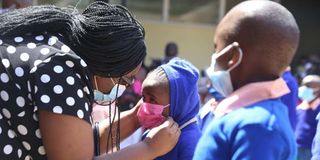Report reveals poor mask use, social distancing among learners

Nairobi Metropolitan Services School Health Coordinator Madaraka Sub-County Naomi Kigani helps a pupil at Muthurwa Primary School to put on a facemask after donating masks and sanitizers to the school on January 6, 2021.
Majority of learners in primary and secondary schools are not wearing masks properly while others are not wearing them, exposing them to the risk of contracting Covid-19 virus, a new report has shown.
The report released by the Constitution and Reform Education Consortium (CRECO) this month shows that schools have inadequate funding and are unable to purchase masks for needy students.
The report also indicates that although almost all schools were able to put up hand washing stations, the capitation given to schools by the Ministry of Education is not enough to enable them to cater for continuous provision of soap and water for hand washing.
Social distancing also remains a major challenge in most of the learning institutions as the 1.5 meters social distancing is not being observed. The study found out that some schools created more space by putting up tents and converting rooms that were not previously used into classes to facilitate social distancing.
“Those who indicated that the measures are not adequate cited social distancing as the major challenge due to large population of students coupled with insufficient classes, dormitories and teachers,” reads the report.
According to the ministries of Health and Education health protocols for safe reopening, schools were required to ensure that learners and teachers wear masks properly at all times while in session. Schools were also required to ensure learners wash their hands before entering the school gate and undergo daily temperature screening.
On access to digital learning during the Covid-19 pandemic, the report shows that despite the government and key stakeholders putting in place various interventions to ensure learners continued to learn during the full and partial closure of schools, the interventions benefited less than a quarter of the learners. It recommends that the government invests in improving ICT infrastructure in all schools and ensuring that each school has an ICT instructor.
The report also reveals that, there is lack of implementation and audit reports on how the Sh6.5 billion allocated to education under the stimulus programme was utilised.
The funds were meant for the recruitment of 1,000 ICT intern teachers, 10,000 teachers and the purchase of 622,357 desks and chairs for public primary and secondary schools.





